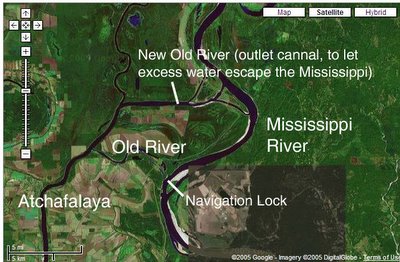The Control of Nature

While my column is washing, and my brain is fried, I should finally write this entry ...
A while back, right around the time of Katrina, I read a spectacular book, The Control of Nature by John McAfee (Amazon site).
When man's interests conflict with an ever changing environment, what does man do? He/she fights change.
(All images were hijacked from maps.google.com.)
Part 1
The Army Corps of Engineers vs the Mississippi River.
As time goes on rivers carry sediment from their sources to their deltas. The sediment settles, the riverbed rises until the river overflows and takes a new steeper route to the sea. But not the Mississippi. After the war of 1812, the Army Corps of Engineers was commissioned to protect New Orleans and the mouth of the Mississippi from future sieges. Eventually the Army Corps took control of the whole river. From Baton Rouge to the big easy, millions now depend on this great river, but the river wants to switch course to the Atchafalaya. Old River (see map) connects the Mississippi to the Atchafalaya, is now dammed. Walls that are longer, wider and taller than the great wall of China, hold the Mississippi in it's current itinerary. The elevated river has become an aqueduct. To read this part of the book, click here.

Part 2
Vestmannaeyjar, Iceland vs the Mid-Atlantic Ridge
Your home is right where two tectonic plates rip apart. A nearby volcano erupts, the lava is heading to your town and the only harbor in your country. What do you do? Water the lava of course (or as the locals call it, "pissing on the lava"). And those crazy Icelanders managed to stop the lava in the nick of time (see map). This crazy tale is too incredible to believe. The Icelanders were even walking on the lava to water it from the top. If the lava-watermen stood still, their boots would catch on fire. At some point a chunk of the volcano (Eldfell) broke off and drifted on the lava towards their town. Migrating Mountains?? Read the book to find out what happened next. Here's a nice website on the whole affair.

Part 3
Los Angeles vs. the Sierra Madre
You city fills an entire valley and is creeping towards an incredibly high (and young) mountain range to the north. Due to tectonic plate movement (see arrows) this mountain range is growing. Every couple of decades avalanches from the growing mountains turn into mud slides that engulf whole sections of the city. But that's not all. The climate is very arid and the vegetation is highly combustible. Driven by evolution, many plants emit flammable oils to encourage the scorching of themselves and competing plants turning these new mountains into fire drenched infernos every 10-30 years. Once the area is reduced to ashes, their heat resistant seeds sprout. Mudslides, wild fires, and still people want to live in L.A.?

Having examined these 3 examples, I had many questions. But one principle stood out,
Sometimes, progress = resistance to change.
Look at the Kyoto protocol. Look at our unsustainable business practices. What will happen if the sea levels rise? It looks like instead of moving our coastal cities, we will erect huge dikes. We humans use technology to find quick fixes ... but such a strategy may lead to our eventual downfall.


<< Home